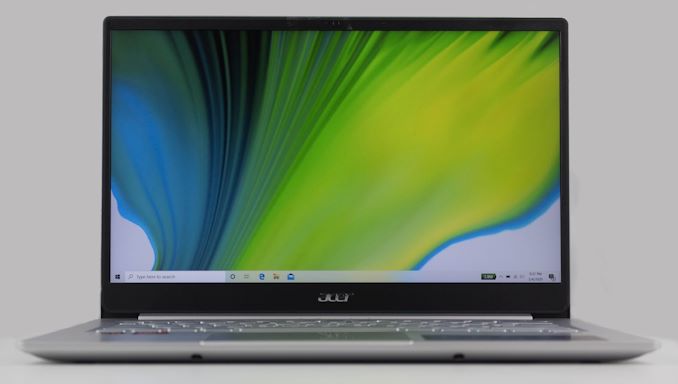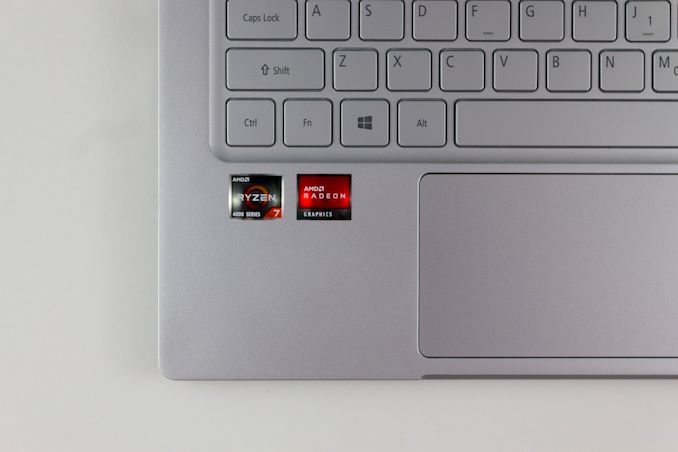The Acer Swift 3 SF314 Notebook Review: Swift Gets Swifter With Ryzen 4000
by Brett Howse & Andrei Frumusanu on May 5, 2020 8:00 AM EST
Almost two years ago to the day, we had a chance to check out Acer’s Swift 3 laptop featuring AMD's first Ryzen Mobile platform, Raven Ridge. Acer has been a strong partner for AMD, generally being one of the first out of the gate with new designs featuring AMD’s latest platforms, and this year that partnership has played out again. Today we are taking a look at the newest AMD APU offering, the Ryzen 4000 "Renoir", which is at the heart of Acer’s latest iteration of the 14-inch Swift 3. With a brand-new AMD processor and some innovations in the Swift 3 design itself, both AMD and Acer have made some tremendous improvements for 2020.
Ryzen 7 4700U
The big news for 2020 is AMD’s new APU platform, codenamed Renoir. Selling as the Ryzen 4000 series, these new APUs bring a number of major updates to AMD's platform, as the company further sands down the rough edges from the Ryzen 3000 Picasso series. Key to this is a much-needed jump from GlobalFoundries' 12nm process to TSMC's class-leading 7nm process, giving AMD a much-wanted boost in transistor performance and overall energy efficiency. Coupled with a number of further optimizations at the chip and driver level, and AMD's latest APUs are proving far better suited for thin-and-light mobile designs than their predecessors.
Under the hood, like AMD's desktop processors introduced last year, the new Ryzen 4000 series APUs are the first laptop-focused products from AMD which feature their Zen 2 CPU cores. Designed hand-in-hand with TSMC's 7nm process, the Zen 2 architecture has further boosted AMD's performance across both IPC and clockspeeds, and the small cores have allowed AMD to get away with 8 of them in even a laptop APU. Meanwhile the iGPU is based on the same Vega architecture graphics as both the 2000-series and 3000-series APUs, but in a new configuration. Thanks to TSMC’s 7nm process, AMD has been able to crank up the GPU frequency much higher than before – so much higher that they’ve actually scaled back on the number of GPU compute units, while still promising improved GPU performance over the previous generation of APUs.
Ian had a chance to take the new Ryzen 4000 platform for a spin in early April, although that sample was the 45-Watt H series. Many of the concepts carry across though, so if you’ve not yet had a chance to catch up on Renoir, be sure to check out the Ryzen 9 4900HS review. The 45-Watt processor range is pretty much the standard in high-performance notebooks, but the vast majority of laptops on the market stick to the lower-powered 15-Watt range, which is what we have in the Acer Swift 3.
Acer has opted for what is likely to be one of the most popular SKUs in the AMD Ryzen 4000 range, the Ryzen 7 4700U. AMD has gone a very non-traditional route for this part, offering eight physical CPU cores, but disabling simultaneous multithreading (SMT). All of AMD’s H-Series lineup of 45-Watt processors do offer SMT, but only two of the new U-Series provide this, with the Ryzen 5 4600U offering 6 cores and 12 threads, and the Ryzen 7 4800U providing 8 cores and 16 threads, all in the 15-Watt thermal design power (TDP) that is so common on laptops. In the typical 15-Watt laptop space, AMD is the first to offer 8 cores, just not always with SMT.
On the GPU side, the Ryzen 7 4700U offers 7 Vega-architecture Compute Units (CUs), with a maximum clockspeed of 1600 MHz. Compared to the previous generation Ryzen 7 3700U, the GPU drops three compute units, but bumps the maximum frequency from 1300 MHz to 1600 MHz, so we shall see where this plays out in terms of performance.
The Acer Swift 3
Acer has managed to bundle a lot of product into the Swift 3. The 14-inch notebook features a 1920x1080 IPS display that, albeit lacking touch support, does get showcased well thanks to the Swift 3's thin bezel surround. The laptop ships with 8 GB of DDR4-3200, and though we would have loved to see LPDDR4X, the capacity is what is important here, and 8 GB is a good amount for a budget-friendly laptop like the Swift 3. Also, Acer has managed to outfit this notebook with a 512 GB SSD, which is fantastic. They will also be offering a less-expensive version with a Ryzen 5 4500U, 8 GB of RAM, and a 256 GB SSD.
| Acer Swift 3 SF314-42 | |||||
| Ryzen 5 | Ryzen 7 Model Reviewed |
||||
| CPU | AMD Ryzen 5 4500U 6 core 6 thread 2.3-4.0 GHz 2x 4MB L3 15W TDP |
AMD Ryzen 7 4700U 8 core 8 thread 2.0-4.1 GHz 2x 4MB L3 15W TDP |
|||
| GPU | AMD Vega 6 6 CUs 1500MHz Boost |
AMD Vega 7 7 CUs 1600MHz Boost |
|||
| RAM | 8 GB Dual-Channel DDR4-3200 | ||||
| Storage | 256 GB PCIe NVMe SSD | 512 GB PCIe NVMe SSD | |||
| Display | 14-inch 1920x1080 IPS | ||||
| Networking | Intel Wi-Fi 6 AX200 2x2:2 802.11ax Bluetooth 5.0 |
||||
| Audio | Stereo Speakers DTS Sound |
||||
| Battery | 48 Wh Li-Ion 65-Watt Charger (barrel connector) USB Power Delivery Support |
||||
| Right Side | USB 2.0 x 1 Headset jack Battery Charge Indicator |
||||
| Left Side | USB 3.2 Gen 1 x 1 with power-off charging USB 3.2 Gen 2 Type-C w/DisplayPort, PD HDMI 2.0 Charging connector |
||||
| Dimensions | 323.4 x 218.9 x 15.95 mm 12.73 x 8.62 x 0.63 inches |
||||
| Weight | 1.2 kg / 2.65 lbs | ||||
| Camera | 720p Super High Dynamic Range | ||||
| Extras | Fingerprint Reader | ||||
| Price (MSRP) | $629 USD | $649 USD | |||
Despite the strong APU, RAM, and storage offerings, Acer is not done there. The Swift 3 also features Wi-Fi 6 thanks to Intel’s AX200 wireless adapter, which means 2.4/5.0 GHz wireless support with 160 Mhz channels if your router is has the correct capabilities. There’s also an integrated fingerprint reader for Windows Hello Support, and the entire package is contained in an all-aluminum chassis which weighs just 1.2 kg / 2.65 lbs. Considering the $649 MSRP, this is an incredible value.











191 Comments
View All Comments
psychobriggsy - Tuesday, May 5, 2020 - link
Yeah, but then you're stuck with two small SODIMMs to replace when you want more memory...My 2700U HP came with 1 8GB stick, buying another stick later on when I needed to double capacity was a lot cheaper than rebuying the full desired capacity.
OTOH 16GB isn't a lot these days - and I'd prefer to get the 16GB in soldered fast LPDDR4X form with Renoir and hope I never need 32GB!
ads295 - Tuesday, May 5, 2020 - link
So I guess you'd have to plan ahead, then. I was going to upgrade to 4x2 initially but I went with 8x2 after some consideration.But would you really need more than 16 if you're a casual user? What are your workloads like? I do light gaming, web browsing and that sort and even 8 would've been enough for me.
fmcjw - Tuesday, May 5, 2020 - link
Lenovo Yoga series was the worst with their single channel atrocities, hope they come to their senses in 2020.Swift 5 2020 (only offered with Intel, no AMD configs I know of) has 8GB onboard with an empty slot running in single channel, but I'm curious how many users think to add another stick. In that case 16GB of onboard RAM is better, at least it reduces BSOD from mismatched RAM.
BTW, if you add a 16GB SO-DIMM to the 8GB onboard, do you get at least the same performance and benefits as 16GB in dual channel mode, or does it create instabilities and other system-wide complications?
csp4me - Tuesday, May 5, 2020 - link
please check your sources man, Swift 5 2020 under 1 kg can never have empty slots, everything is soldered. https://www.notebookcheck.net/Acer-Swift-5-Laptop-...fmcjw - Wednesday, May 6, 2020 - link
You're right, thanks, I got it mixed up with the LG Gram (2020). Acer is soldered.Spunjji - Wednesday, May 6, 2020 - link
Adding a 16GB SO-DIMM to a system with 8GB soldered gives you dual-channel performance for the first 16GB pool of system RAM, with the remaining 8GB running at single-channel performance.neblogai - Tuesday, May 5, 2020 - link
Regarding RAM: at least in China, Swift 3 models with 8GB come with LPDDR4 3200, but there is also a 16GB version, and that uses LPDDR4X 4266, costing ~15% more. It came a ~month later than the 8G model.eddieobscurant - Tuesday, May 5, 2020 - link
I don't understand why they don't offer a model with more ram. 8gb, non-upgradable ram is too low.Holliday75 - Tuesday, May 5, 2020 - link
For who? Most business and casual users 8gb is plenty.My company has 10's of thousands of 8gb laptops deployed and we rarely see the need for more and my users love their huge ass spreadsheets and Chrome. Most home users like my family and friends would be fine with it as their workloads are not as robust.
Me personally I would like 16gb for home use as I game. At work I am happy with my 4th gen Intel processor and 8gb of RAM.
RinzImpulse - Wednesday, May 6, 2020 - link
Umm... don't forget that system RAM will be shared with iGPU, so, most likely you'll only get 6-7 GB free for windows which I'm sure it won't be enough even for most